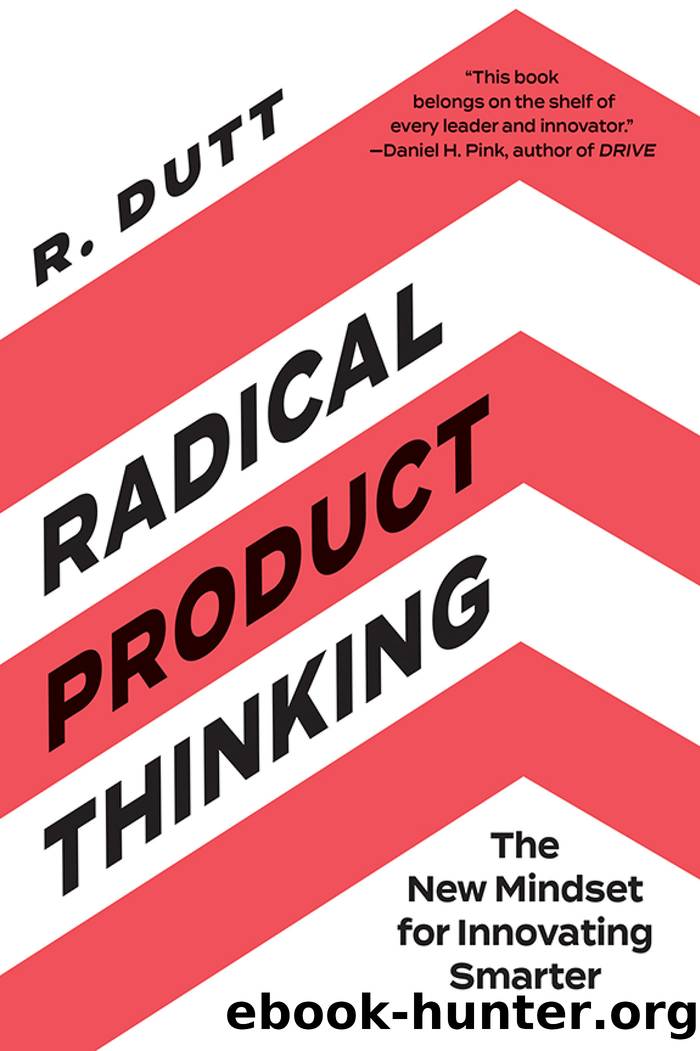Radical Product Thinking by R. Dutt

Author:R. Dutt
Language: eng
Format: epub
Publisher: Berrett-Koehler Publishers
This sounds remarkably aligned with the RPT approach of defining a clear vision and strategy and translating it into priorities and execution.
Ironically, setting performance goals and OKRs can drive pursuits of local maxima and distract us from finding the global maximum. Itâs time to abandon the approach of using product metrics to set performance goals. Itâs time for a more radical approach.
MEASUREMENT THE RPT WAY
The RPT approach to measurement is designed as a collaborative approach to help your team to continuously learn and improve your product in an ethical manner. This means aligning the team on what metrics indicate whether your product is creating the change you intended and then managing progress through regular feedback.
OKRs too were intended to create alignment by quantifying the impact the organization strives to create. Most organizations have broad vision statements and havenât yet transitioned to Radical Vision Statements. In the absence of a detailed vision, OKRs offer a detailed narrative of the desired impact, but these come with side effects. To achieve the same alignment without the side effects of goal setting, start by creating a Radical Vision Statement.
The RPT approach to crafting a vision gives teams a clear picture of the world youâre collectively bringing about, and the RDCL strategy helps you translate that vision into an actionable plan. You can use the vision and strategy to align the team on the direction and magnitude of the change you want to bring about. By running these cocreation sessions as group exercises, youâll have the teamâs participation and buy-in on where youâre going.
Once you have a clear vision and strategy, you can list the key metrics that would indicate progressâjust refrain from setting targets. Periodically youâll need to review whether these metrics continue to be the right ones to measure.
If youâre changing from measuring popular metrics to whatâs right for your organization, you may need to educate your team and investors on how you measure success. Itâs easy to fall prey to setting your measurement strategy based on how investors or stakeholders might define traction. In an organization where ease of use was defined as âanything should be one click away,â the team had developed a website where any information you needed was one click away on the home pageâif you could find it, that is.
When the team built a replacement for this product that organized information well, many elements that used to be on the home page were moved behind a tiered menu. Success for us wasnât about the number of clicks it took users to find what they were looking for but whether people spent less time on the site because they found what they needed very quickly. In making these changes, we needed to communicate a change in how we were measuring success. This alignment is also important because measurement costs time and resourcesâboth to build the ability to capture the data and analyze the data when it becomes available.
Once you have alignment on what to measure, you can begin to share and discuss product metrics.
Download
This site does not store any files on its server. We only index and link to content provided by other sites. Please contact the content providers to delete copyright contents if any and email us, we'll remove relevant links or contents immediately.
Whiskies Galore by Ian Buxton(41716)
Introduction to Aircraft Design (Cambridge Aerospace Series) by John P. Fielding(33015)
Small Unmanned Fixed-wing Aircraft Design by Andrew J. Keane Andras Sobester James P. Scanlan & András Sóbester & James P. Scanlan(32683)
Craft Beer for the Homebrewer by Michael Agnew(18079)
Turbulence by E. J. Noyes(7891)
The Complete Stick Figure Physics Tutorials by Allen Sarah(7263)
Kaplan MCAT General Chemistry Review by Kaplan(6820)
The Thirst by Nesbo Jo(6752)
Bad Blood by John Carreyrou(6474)
Modelling of Convective Heat and Mass Transfer in Rotating Flows by Igor V. Shevchuk(6352)
Learning SQL by Alan Beaulieu(6158)
Weapons of Math Destruction by Cathy O'Neil(6082)
Man-made Catastrophes and Risk Information Concealment by Dmitry Chernov & Didier Sornette(5875)
Digital Minimalism by Cal Newport;(5583)
Life 3.0: Being Human in the Age of Artificial Intelligence by Tegmark Max(5402)
iGen by Jean M. Twenge(5320)
Secrets of Antigravity Propulsion: Tesla, UFOs, and Classified Aerospace Technology by Ph.D. Paul A. Laviolette(5236)
Design of Trajectory Optimization Approach for Space Maneuver Vehicle Skip Entry Problems by Runqi Chai & Al Savvaris & Antonios Tsourdos & Senchun Chai(4955)
Electronic Devices & Circuits by Jacob Millman & Christos C. Halkias(4863)
